Page 14 of 356
Downloaded from www.Manualslib.com manuals search engine e Section 1 Seats and Restraint Systems
Here you’ll find information about the seats in your Corvette and how to use your safety belts properly. You can also
learn about some things you should not do with air bags and safety belts.
1-2
1-6
1-10
1-11
1-12
1-18
1-19
Seats and Controls
Safety Belts: They’re for Everyone
Here Are Questions Many People Ask About
Safety Belts
-- and the Answers
How to Wear Safety Belts Properly
Driver Position
Safety Belt Use During Pregnancy
Passenger Position
1-19
1-25
1-27
1-30
1-33
1-33
1-34 Air Bag System
Children
Child Restraints
Larger Children
Safety Belt Extender
Checking Your Restraint Systems
Replacing Restraint System Parts
After a Crash
1-1
Page 24 of 356
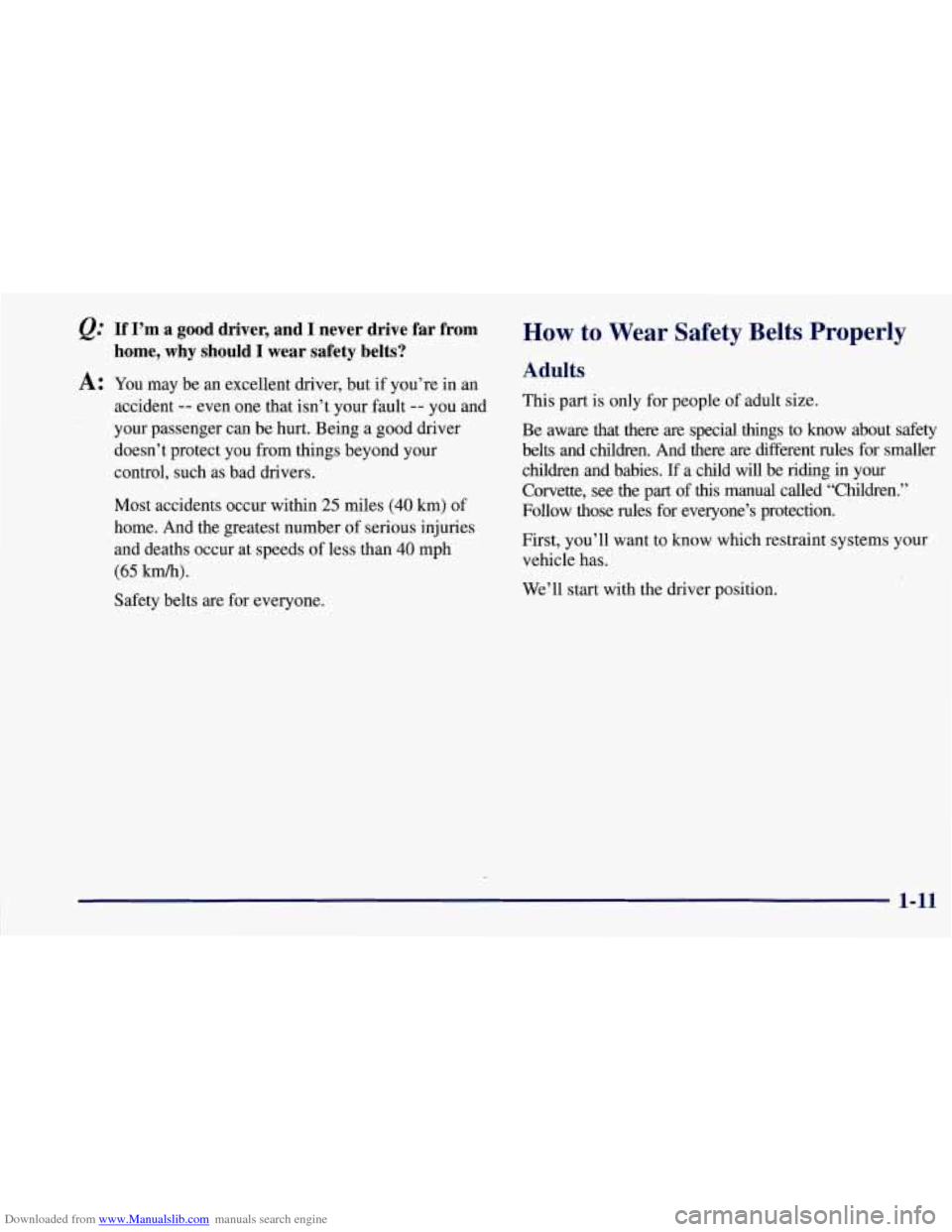
Downloaded from www.Manualslib.com manuals search engine Q: If I’m a good driver, and I never drive far from
A: You may be an excellent driver, but if you’re in an
home, why should I wear safety belts?
accident -- even one that isn’t your fault -- you and
your passenger can be hurt. Being a good driver
doesn’t protect you from things beyond your
control, such as bad drivers.
Most accidents occur within
25 miles (40 km) of
home. And the greatest number
of serious injuries
and deaths occur at speeds of less than
40 mph
(65 km/h).
Safety belts are for everyone.
How to Wear Safety Belts Properly
Adults
This part is only for people of adult size.
Be aware that there are special things to know about safety
belts and children. And there
are different rules for smaller
children and babies.
If a child will be riding in your
Corvette, see
the part of this manual called “Children.”
Follow
those rules for everyone’s protection.
First, you’ll want to know which restraint systems your
vehicle has.
We’ll start with the driver position.
1-11
Page 38 of 356
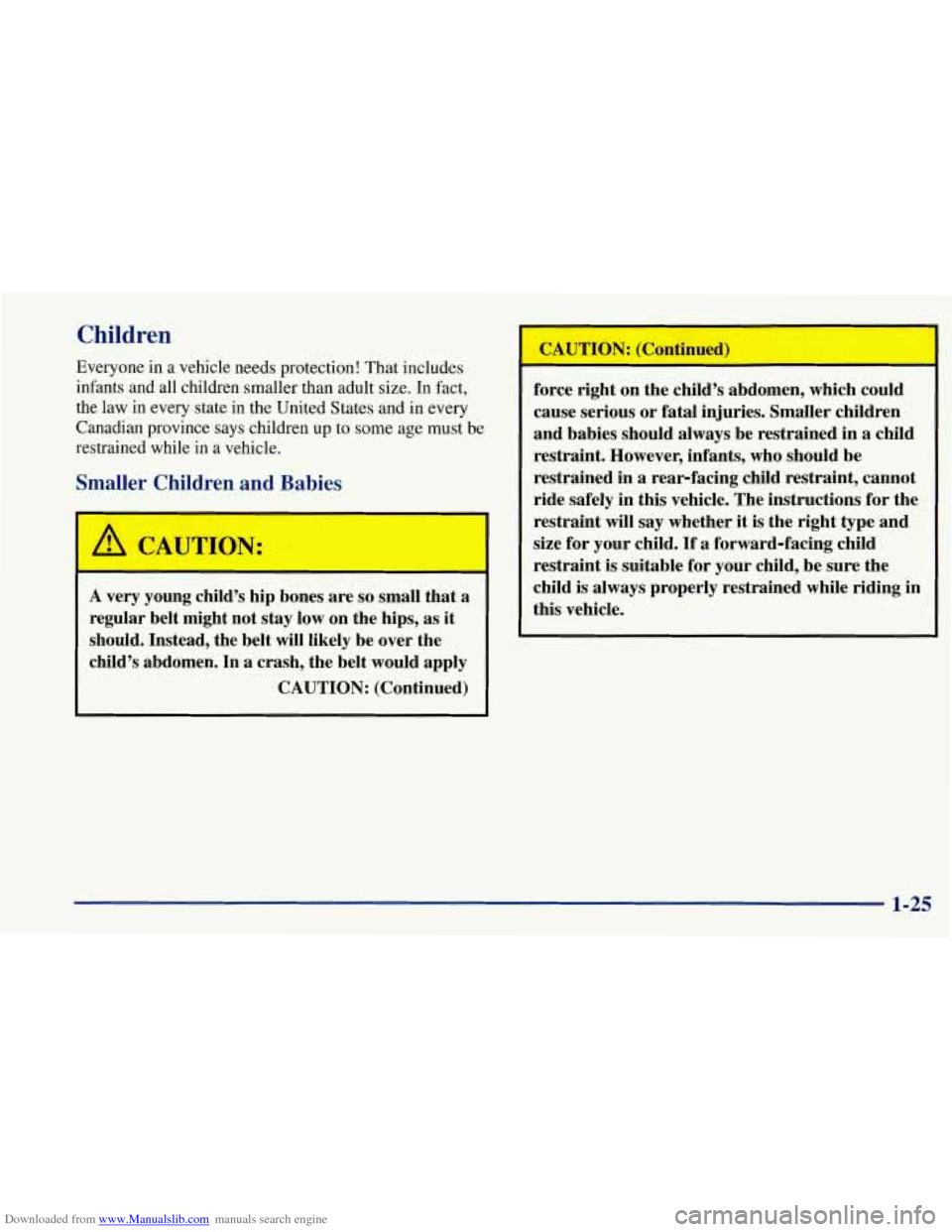
Downloaded from www.Manualslib.com manuals search engine Children
Everyone in a vehicle needs protection! That includes
infants and all children smaller than adult size.
In fact,
the law in every state in the United States and in every
Canadian province says children up to some age must be
restrained while in a vehicle.
Smaller Children and Babies
I
A very young child’s hip bones are so small that a
regular belt might not stay low on the hips, as it
should. Instead, the belt will likely be over the
child’s abdomen.
In a crash, the belt would apply
CAUTION: (Continued) force
right on the child’s abdomen, which could
cause serious or fatal injuries. Smaller children
and babies should always be restrained in a child
restraint. However, infants, who should be
restrained in a rear-facing child restraint, cannot
ride safely in this vehicle. The instructions for the
restraint will say whether it is the right type and
size for your child.
If a forward-facing child
restraint is suitable for your child, be sure the
child is always properly restrained while riding in
this vehicle.
1-25
Page 40 of 356
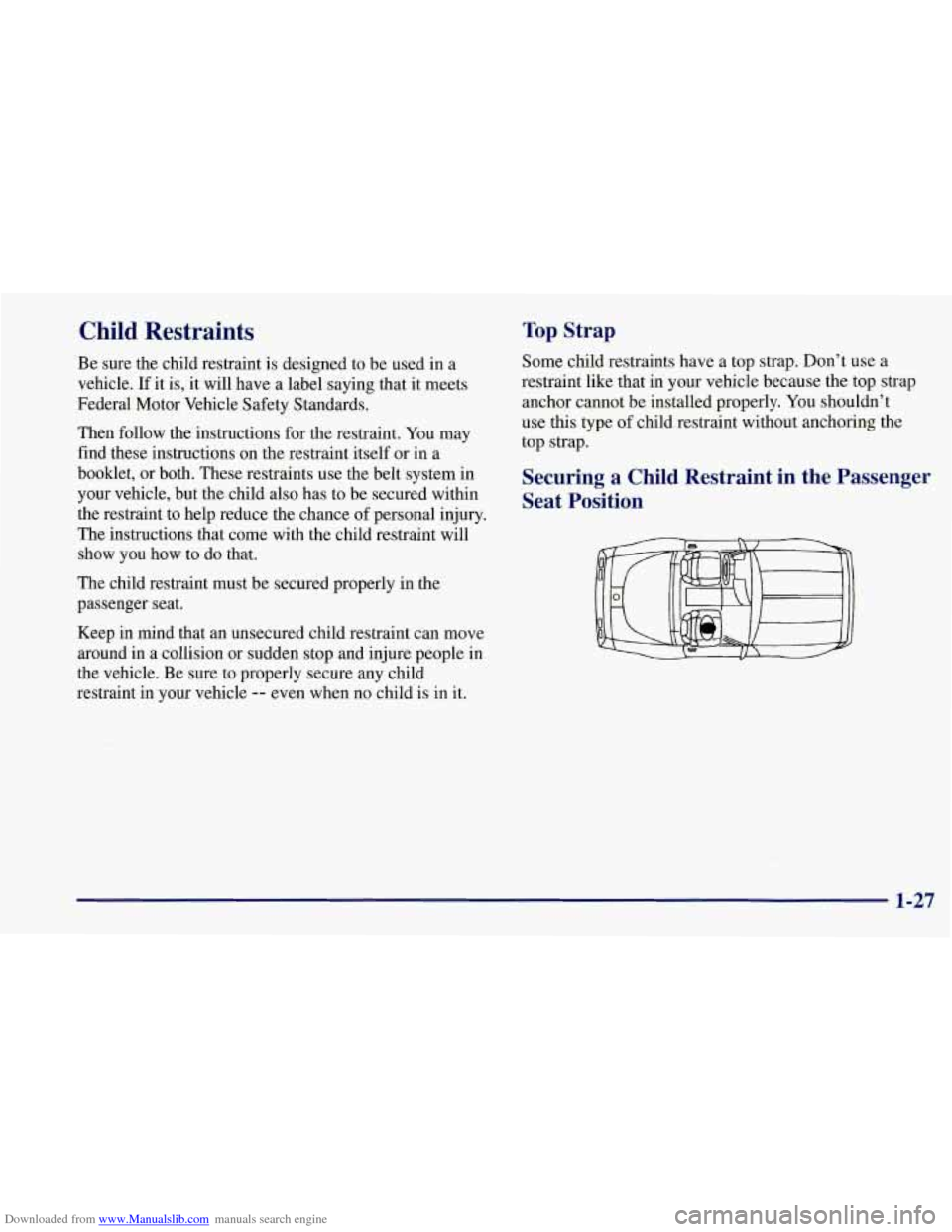
Downloaded from www.Manualslib.com manuals search engine Child Restraints
Be sure the child restraint is designed to be used in a
vehicle.
If it is, it will have a label saying that it meets
Federal Motor Vehicle Safety Standards.
Then follow the instructions for the restraint. You may
find these instructions on the restraint itself or in a
booklet, or both. These restraints use the belt system in
your vehicle, but the child also has to be secured within
the restraint to help reduce the chance of personal injury.
The instructions that come with the child restraint will
show you how to do that.
The child restraint must be secured properly in the
passenger seat.
Keep in mind that an unsecured child restraint can move
around in a collision or sudden stop and injure people in
the vehicle. Be sure to properly secure any child
restraint in your vehicle
-- even when no child is in it.
Top Strap
Some child restraints have a top strap. Don’t use a
restraint like that in your vehicle because the top strap
anchor cannot be installed properly. You shouldn’t
use this type of child restraint without anchoring the
top strap.
Securing a Child Restraint in the Passenger
Seat Position
1-27
Page 41 of 356
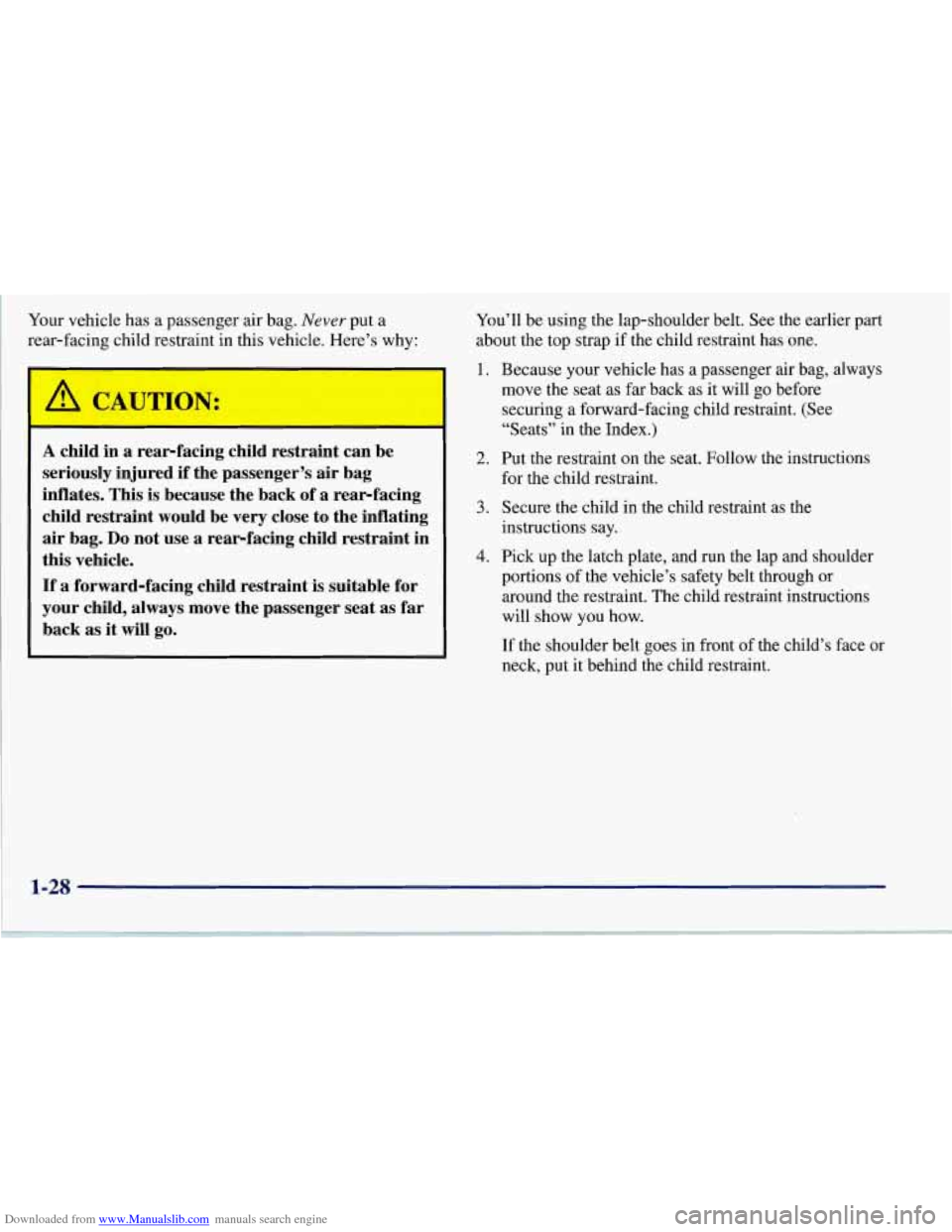
Downloaded from www.Manualslib.com manuals search engine Your vehicle has a passenger air bag. Never put a
rear-facing child restraint in this vehicle. Here’s why:
A child in a rear-facing child restraint can be
seriously injured if the passenger’s air bag
inflates. This is because the back of a rear-facing
child restraint would be
very close to the inflating
air bag.
Do not use a rear-facing child restraint in
this vehicle.
If a forward-facing child restraint is suitable for
your child, always move the passenger seat as far
back as it will go.
You’ll be using the lap-shoulder belt. See the earlier part
about the top strap if the child restraint has one.
1.
2.
3.
4.
Because your vehicle has a passenger air bag, always
move the seat as far back as it will
go before
securing a forward-facing child restraint. (See
“Seats” in the Index.)
Put the restraint on the seat. Follow the instructions
for the child restraint.
Secure the child in the child restraint as the
instructions say.
Pick up the latch plate, and run the lap and shoulder
portions of the vehicle’s safety belt through or
around the restraint. The child restraint instructions
will show you how.
If the shoulder belt goes in front of the child’s face
or
neck, put it behind the child restraint.
1-28
Page 43 of 356
Downloaded from www.Manualslib.com manuals search engine 7. To tighten the belt, feed the lap belt back into the
8. Push and pull the child restraint in different
retractor
while you push down on the child restraint.
directions to be sure it
is secure.
To remove the child restraint, just unbuckle the vehicle's
safety belt and
let it go back all the way. The safety belt
will move freely again and be ready to work for an adult
or larger child passenger.
Larger Children
Children who have outgrown child restraints should
wear the vehicle's safety belts.
Children who aren't buckled up can be thrown out in
a crash.
Children who aren't buckled up can strike other
people who are.
1-30
Page 44 of 356
Downloaded from www.Manualslib.com manuals search engine Never do this.
Here two children are wearing the same belt. The
belt can’t properly spread the impact forces.
In a
crash, the two children can be crushed together
and seriously injured.
A belt must be used by
only one person at
a time.
&.” What if a child is wearing a lap-shoulder belt,
but the child is so small that the shoulder belt is
very close to the child’s face or neck?
A: Move the child toward the center of the vehicle, but
be sure that the shoulder belt still is
on the child’s
shoulder,
so that in a crash the child’s upper body
would have the restraint that belts provide.
1-31
Page 210 of 356
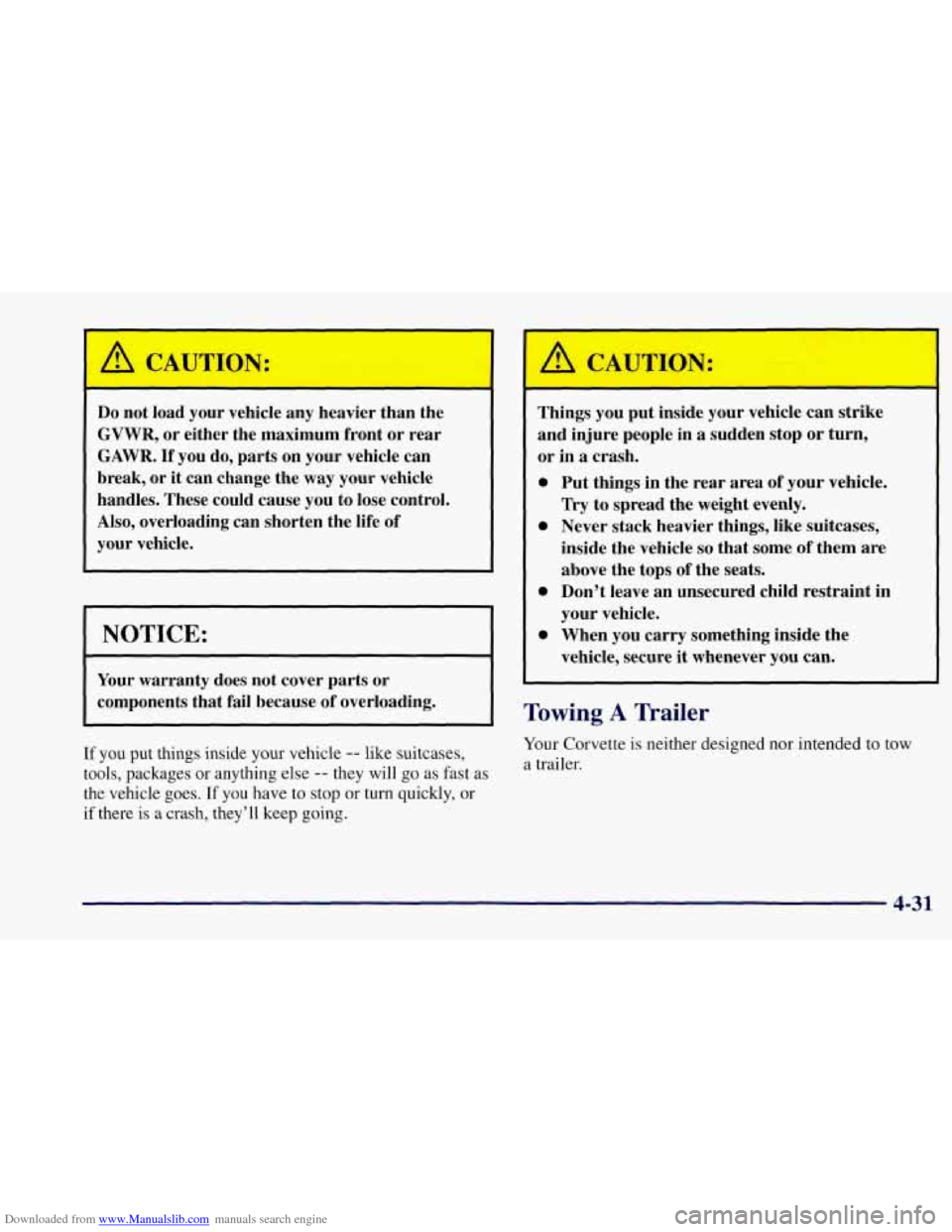
Downloaded from www.Manualslib.com manuals search engine ' A CA"T1ON:
-
Do not load your vehicle any heavier than the
GVWR, or either the maximum front or rear
GAWR. If you do, parts on your vehicle can
break, or
it can change the way your vehicle
handles. These could cause you to lose control.
Also, overloading can shorten the life of
your vehicle.
NOTICE:
Your warranty does not cover parts or
components that fail because of overloading.
~~ ~ ~ ~ ~~ ~ ~~~ ~ ~~ ~
If you put things inside your vehicle -- like suitcases,
tools, packages or anything else
-- they will go as fast as
the vehicle goes.
If you have to stop or turn quickly, or
if there is a crash, they'll keep going.
__ --_I ,
Things you put inside your vehicle can strike
and injure people in a sudden stop or turn,
or in
a crash.
0 Put things in the rear area of your vehicle.
Try to spread the weight evenly.
0 Never stack heavier things, like suitcases,
inside the vehicle
so that some of them are
above the tops
of the seats.
0 Don't leave an unsecured child restraint in
your vehicle.
0 When you carry something inside the
vehicle, secure
it whenever you can.
Towing A Trailer
Your Corvette is neither designed nor intended to tow
a trailer.
4-31